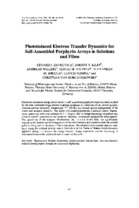| dc.contributor.author | Zenkevich, E. I. | en |
| dc.contributor.author | Kilin, D. S. | en |
| dc.contributor.author | Willert, A. | en |
| dc.contributor.author | Bachilo, S. M. | en |
| dc.contributor.author | Shulga, A. M. | en |
| dc.contributor.author | Rempel, U. | en |
| dc.contributor.author | Borczyskowski, C. von | en |
| dc.date.accessioned | 2017-05-26T10:58:35Z | |
| dc.date.available | 2017-05-26T10:58:35Z | |
| dc.date.issued | 2001 | |
| dc.identifier.citation | Photoinduced electron transfer dynamics for self-assembled porphyrin arrays in solutions and films / E. I. Zenkevich [et al.] // Molecular Crystals and Liquid Crystals. – 2001. – Vol. 326. – P. 83-88. | en |
| dc.identifier.uri | https://rep.bntu.by/handle/data/30164 | |
| dc.description.abstract | Electronic excitation energy deactivation in self-assembled porphyrin triads has been studied by the time correlated single photon counting technique as a function of the solvent polarity (toluene-acetone mixtures), temperature (77-350 K), and mutual spatial arrangement of the donor and acceptor subunits. The donor (Zn-octaethylporphyrin chemical dimer) fluorescence quenching with time constant of 1.7÷10 ps is due to competing energy migration and electron transfer processes to the acceptor (dipyridyl substituted tetrapyrrole extra-ligand). The quenching of the acceptor fluorescence (by ~ 1.3–1.6 times) does not significantly depend on the mutual spatial arrangement of the triad subunits and increases with the solvent
polarity rising and the decrease of the temperature. The obtained experimental data are analyzed using the reduced density matrix formalism in the frame of Haken-Strobl-Reineker approach taking into account the energy transfer, charge separation, and the dephasing of coherence between the excited electronic states of the triad. | en |
| dc.language.iso | en_US | en |
| dc.title | Photoinduced electron transfer dynamics for self-assembled porphyrin arrays in solutions and films | en |
| dc.type | Article | ru |
| dc.identifier.doi | 10.1080/10587250108025722 | |

